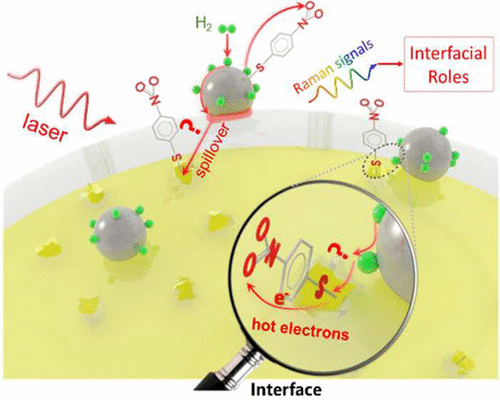当前位置:
X-MOL 学术
›
J. Am. Chem. Soc.
›
论文详情
Our official English website, www.x-mol.net, welcomes your
feedback! (Note: you will need to create a separate account there.)
Revealing the Role of Interfacial Properties on Catalytic Behaviors by in Situ Surface-Enhanced Raman Spectroscopy
Journal of the American Chemical Society ( IF 14.4 ) Pub Date : 2017-07-25 00:00:00 , DOI: 10.1021/jacs.7b04011 Hua Zhang 1 , Xia-Guang Zhang 1 , Jie Wei 1 , Chen Wang 1 , Shu Chen 1 , Han-Lei Sun 1 , Ya-Hao Wang 1 , Bing-Hui Chen 1 , Zhi-Lin Yang 1 , De-Yin Wu 1 , Jian-Feng Li 1 , Zhong-Qun Tian 1
Journal of the American Chemical Society ( IF 14.4 ) Pub Date : 2017-07-25 00:00:00 , DOI: 10.1021/jacs.7b04011 Hua Zhang 1 , Xia-Guang Zhang 1 , Jie Wei 1 , Chen Wang 1 , Shu Chen 1 , Han-Lei Sun 1 , Ya-Hao Wang 1 , Bing-Hui Chen 1 , Zhi-Lin Yang 1 , De-Yin Wu 1 , Jian-Feng Li 1 , Zhong-Qun Tian 1
Affiliation

|
Insightful understanding of how interfacial structures and properties affect catalytic processes is one of the most challenging issues in heterogeneous catalysis. Here, the essential roles of Pt–Au and Pt−oxide−Au interfaces on the activation of H2 and the hydrogenation of para-nitrothiophenol (pNTP) were studied at molecular level by in situ surface-enhanced Raman spectroscopy (SERS) and shell-isolated nanoparticle-enhanced Raman spectroscopy (SHINERS). Pt–Au and Pt–oxide–Au interfaces were fabricated through the synthesis of Pt-on-Au and Pt-on-SHINs nanocomposites. Direct spectroscopic evidence demonstrates that the atomic hydrogen species generated on the Pt nanocatalysts can spill over from Pt to Au via the Pt–Au and Pt–TiO2–Au interfaces, but would be blocked at the Pt–SiO2–Au interfaces, leading to the different reaction pathways and product selectivity on Pt-on-Au and Pt-on-SHINs nanocomposites. Such findings have also been verified by the density functional theory calculation. In addition, it is found that nanocatalysts assembled on pinhole-free shell-isolated nanoparticles (Pt-on-pinhole-free-SHINs) can override the influence of the Au core on the reaction and can be applied as promising platforms for the in situ study of heterogeneous catalysis. This work offers a concrete example of how SERS/SHINERS elucidate details about in situ reaction and helps to dig out the fundamental role of interfaces in catalysis.
中文翻译:

通过原位表面增强拉曼光谱揭示界面性质对催化行为的作用
对界面结构和性质如何影响催化过程的深刻理解是非均相催化中最具挑战性的问题之一。在这里,通过原位表面增强拉曼光谱(SERS)和壳层研究了Pt-Au和Pt-氧化物-Au界面在H 2活化和对硝基硫酚(pNTP)氢化中的重要作用。分离的纳米粒子增强拉曼光谱(SHINERS)。Pt-Au和Pt-氧化物-Au界面是通过Pt-on-Au和Pt-on-SHINs纳米复合材料的合成而制成的。直接光谱证据表明,Pt纳米催化剂上产生的氢原子可以通过Pt–Au和Pt–TiO 2从Pt溢出到Au-Au界面,但会在Pt-SiO 2 -Au界面处受阻,导致在Au-Pt上和SHN-Pt上的纳米复合材料具有不同的反应途径和产物选择性。密度泛函理论计算也证实了这些发现。此外,发现组装在无针孔的壳分离纳米颗粒上的纳米催化剂(Pt-on-pinhole-free-SHINs)可以覆盖Au核对反应的影响,并且可以用作原位应用的有前途的平台多相催化的研究。这项工作提供了一个具体的例子,说明SERS / SHINERS如何阐明有关原位反应的细节,并有助于挖掘出界面在催化中的基本作用。
更新日期:2017-07-26
中文翻译:

通过原位表面增强拉曼光谱揭示界面性质对催化行为的作用
对界面结构和性质如何影响催化过程的深刻理解是非均相催化中最具挑战性的问题之一。在这里,通过原位表面增强拉曼光谱(SERS)和壳层研究了Pt-Au和Pt-氧化物-Au界面在H 2活化和对硝基硫酚(pNTP)氢化中的重要作用。分离的纳米粒子增强拉曼光谱(SHINERS)。Pt-Au和Pt-氧化物-Au界面是通过Pt-on-Au和Pt-on-SHINs纳米复合材料的合成而制成的。直接光谱证据表明,Pt纳米催化剂上产生的氢原子可以通过Pt–Au和Pt–TiO 2从Pt溢出到Au-Au界面,但会在Pt-SiO 2 -Au界面处受阻,导致在Au-Pt上和SHN-Pt上的纳米复合材料具有不同的反应途径和产物选择性。密度泛函理论计算也证实了这些发现。此外,发现组装在无针孔的壳分离纳米颗粒上的纳米催化剂(Pt-on-pinhole-free-SHINs)可以覆盖Au核对反应的影响,并且可以用作原位应用的有前途的平台多相催化的研究。这项工作提供了一个具体的例子,说明SERS / SHINERS如何阐明有关原位反应的细节,并有助于挖掘出界面在催化中的基本作用。











































 京公网安备 11010802027423号
京公网安备 11010802027423号